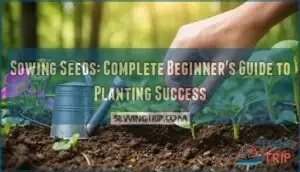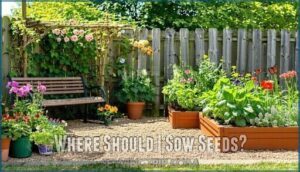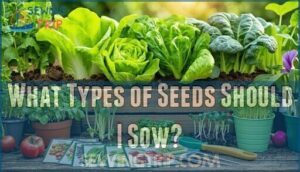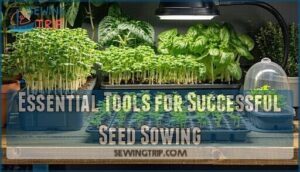This site is supported by our readers. We may earn a commission, at no cost to you, if you purchase through links.

You can sow directly outdoors when soil temperatures hit 60°F or start indoors 6-8 weeks before your last frost. Think of it as giving seeds their perfect launching pad – proper soil preparation and consistent moisture turn those tiny packages of potential into thriving seedlings that’ll reward your efforts all season long.
Table Of Contents
Key Takeaways
- You’re planting seeds, not stitching fabric – "Sowing seeds" means placing seeds in soil to grow plants, while "sewing" involves needle and thread work.
- Plant seeds at the right depth and timing – Use the 2-3 times seed diameter rule for depth and wait until soil temperatures hit 60°F for outdoor sowing.
- Choose between indoor or outdoor methods – Start seeds indoors 6-8 weeks before the last frost for control, or sow directly outdoors when conditions are right.
- Keep soil consistently moist but not waterlogged – Your seeds need steady moisture like a wrung-out sponge, not swampy conditions that’ll kill germination.
What Does It Mean to Sow Seeds?
Every gardener starts somewhere, and sowing seeds is your gateway into growing your own plants. When you sow seeds, you’re basically scattering them in soil where they can germinate and flourish – think of it as planting tiny promises for future harvests.
Sowing seeds means planting hope and watching it grow
Seed sowing techniques vary depending on your approach. Indoor sowing gives you complete control over environmental conditions, using seed-starting mix in containers under grow lights. It’s like creating a five-star nursery for your seedlings. Outdoor sowing means working directly with garden soil, scattering seeds and gently raking them under.
Proper soil preparation sets the foundation for successful seed germination. Your soil should drain well but retain enough moisture to keep seeds happy. Whether you choose indoor or outdoor methods, seed selection matters – match your chosen varieties to your growing conditions and climate.
Understanding the historical language patterns can also help gardeners appreciate the nuances of terminology in their field.
This gardening basics approach connects you to nature’s rhythm while minimizing environmental impact through sustainable growing practices.
When is The Best Time to Sow Seeds?
Timing truly holds the secret to successful seed sowing. **You’ll want to sow seeds based on frost dates and climate factors in your area.
Cool-season crops like lettuce and spinach can go in the ground 2-6 weeks before your last expected frost**, while warm-season varieties need soil temperature consistently above 60°F.
Starting seeds indoors gives you a head start – begin 6-8 weeks before transplanting outdoors. Seed germination peaks between 77-91°F, so don’t rush it when soil’s still chilly. Growing seasons vary by location, but most vegetables do best sown between March and July.
Check your seed packets for specific timing – they’re like your gardening GPS, guiding you toward planting success. For ideal results, understanding soil preparation techniques is essential for seed germination and growth.
Where Should I Sow Seeds?
Choosing the right spot can make or break your gardening success. Your climate zones and outdoor spaces determine where seeds will thrive best. Consider these prime locations:
- Sunny garden beds with well-draining soil that warms quickly in spring
- Protected areas near south-facing walls that stay warmer longer
- Raised beds that improve soil quality and drainage naturally
- Containers on patios where you can control garden layout perfectly
Check your seed packets for specific requirements. Some seeds love starting indoors before moving outside, while others prefer direct outdoor sowing when soil conditions improve. Understanding the historical language patterns evolution can also help gardeners appreciate the nuances of terminology used in gardening and sewing.
How Do I Sow Seeds Outdoors?
Rolling up your sleeves for outdoor seed sowing starts with proper soil preparation. Clear your garden area of weeds, stones, and debris, then rake the soil into a fine, crumbly texture that’s perfect for germination.
Here are four key aspects that’ll determine your outdoor sowing success:
- Seed Depth: Plant seeds 2-3 times their diameter deep – tiny lettuce seeds barely need covering while beans go deeper.
- Spacing: Follow your seed packets’ spacing guidelines religiously to prevent overcrowding battles later.
- Watering: Keep soil consistently moist with gentle watering that won’t disturb your freshly sown seeds.
- Weather Conditions: Check soil temperature and wait for workable conditions – muddy soil kills more seeds than drought.
Create shallow rows (called drills) for larger seeds or broadcast smaller ones mixed with sand for even distribution. After sowing, lightly firm the soil to guarantee good seed-to-soil contact. Your garden layout should enhance sunlight exposure while making maintenance easy. Direct sowing works brilliantly for plants that hate transplanting. For ideal results, understanding direct sow seeds is vital for a successful garden.
How Do I Sow Seeds Indoors?
Starting your indoor seed-starting journey feels like bringing spring inside your home. You’ll need a proper setup to create the perfect nursery for your seedlings.
1. Master Your Indoor Lighting Setup
Place seed trays under grow lights or near a south-facing window with 6-8 hours of direct sunlight. Fluorescent lights work great for beginners – keep them 2-3 inches above your seed trays.
Fill seed trays with high-quality soil mixtures designed for germination. Moisten the mix before planting, then sow seeds at depths specified on packets. Most seeds need depths twice their diameter.
Keep soil consistently moist but not waterlogged. Use a spray bottle for gentle watering that won’t disturb tiny seeds. Cover trays with clear plastic domes to maintain humidity during germination.
Germination tips: Maintain temperatures between 65-75°F for most vegetables. Once seedlings emerge, remove covers and provide air circulation to prevent damping-off disease.
When you sow seeds indoors, you’re giving plants a head start on the growing season while maintaining complete control over their early development. Understanding the importance of thread tension control can also help in other areas of DIY projects.
What Types of Seeds Should I Sow?
Selecting the right seeds can make or break your gardening success story. Your seed selection journey starts with understanding what grows well in your climate and matches your skill level.
For beginners, start with foolproof vegetables like lettuce, spinach, and radishes. These leafy greens germinate quickly and forgive rookie mistakes. Root crops such as carrots and beets prefer direct sowing since their delicate taproots don’t like transplanting.
| Easy Starters | Challenge Level |
|---|---|
| Lettuce, Spinach, Kale | Beginner |
| Beans, Peas, Zucchini | Beginner-Intermediate |
| Tomatoes, Peppers | Intermediate |
When choosing the right seeds, check each seed packet for growing requirements. Hybrid seeds offer disease resistance and faster growth, while heirloom varieties provide unique flavors and seed-saving opportunities.
Consider your garden types too – compact varieties work great for containers, while sprawling plants like cucumbers need more space. Quality matters, so buy from reputable suppliers. Choose crop choices that match your family’s eating habits and your region’s growing season. Understanding sewing business models can also help with creative approaches to gardening and DIY projects.
Essential Tools for Successful Seed Sowing
Getting your seed starting setup right makes all the difference between thriving seedlings and disappointed hopes. Your foundation starts with high-quality soilless seedstarting mix – it’s like giving your seeds a five-star hotel instead of roadside motel conditions. Industry standard seedstarting trays with drainage holes prevent that dreaded "swamp foot" your seeds can get from sitting in soggy conditions.
You’ll need seed starting lights to replace the sun when you’re growing indoors. LED or fluorescent fixtures work perfectly for mimicking natural sunlight. Heat mats boost germination rates by keeping soil temperature consistent – think of them as heated blankets for your future plants.
Don’t overlook the supporting cast: clear humidity domes create mini greenhouses, bottom watering trays reduce fungal issues, and basic gardening tools like dibbers help create precise planting holes. For serious growers, greenhouse kits and simple irrigation systems can simplify the whole process. These tools transform seed starting from guesswork into reliable success. Understanding proper sewing gauge techniques can also inform your approach to measuring and spacing seeds for ideal growth.
Frequently Asked Questions (FAQs)
How often should I water my seeds after sowing them?
Drowning your seeds isn’t love—it’s plant murder! **Keep soil consistently moist like a wrung-out sponge.
Check daily by poking your finger into the dirt. Water when the top feels dry but deeper soil stays damp.
How long does it typically take for seeds to germinate?
Most seeds germinate within 5-14 days, but you’ll see variation depending on the type. Quick sprouters like radishes pop up in just 3-5 days, while stubborn ones like peppers might take 2-3 weeks.
Can I sow different types of seeds together in the same container?
Mixing seeds is like throwing different dancers on one stage – they’ll compete for space and resources. You can combine seeds with similar germination times and growing needs, but give each variety adequate room to flourish without crowding its neighbors.
What supplies do I need for seed starting?
You’ll need seed starting trays with drainage, quality soilless mix, seeds, and grow lights. Add clear dome covers for humidity control. Don’t forget containers and a watering system.
How deep should I plant different seeds?
Plant seeds at a depth roughly twice their diameter. Large beans go one inch deep, while tiny lettuce seeds need just a quarter-inch. Check your seed packet for specific guidance.
Why arent my seeds germinating properly?
Your tomato seeds sat in cold, soggy soil for two weeks without sprouting. Check if you’re keeping soil consistently moist but not waterlogged, providing adequate warmth, and ensuring proper planting depth per packet instructions.
Can I save seeds from my plants?
You can absolutely save seeds from your plants! Choose fully ripe, healthy fruits or flowers. Let seeds dry completely before storing in cool, dark places. Open-pollinated varieties work best.
What common mistakes should I avoid when sowing?
Don’t plant dreams in soggy ground – you’ll watch them drown. Avoid sowing too deep, overwatering, using poor soil, ignoring spacing requirements, and skipping hardening off before transplanting outdoors.
Conclusion
Successfully sowing seeds transforms your garden dreams into reality through proper technique and timing. Remember that what’s sewing seeds actually means planting – not stitching!
You’ve learned the fundamentals: correct depth, appropriate spacing, and seasonal timing. Whether you’re starting indoors or direct sowing outdoors, consistent moisture and preparation are key.
Don’t get discouraged if some attempts fail – even experienced gardeners face challenges. Your patience and practice will pay off with bountiful harvests and beautiful blooms.
- https://byjus.com/biology/sowing/
- https://therike.com/blogs/seasonal-seeds/sowing-vs-planting-seeds-explained
- https://farmaction.us/2022/11/10/the-story-of-seeds/
- https://www.slideshare.net/slideshow/different-methods-of-sowing/249464575
- https://www.selectseeds.com/blogs/growing-guides/seed-sowing-guide










